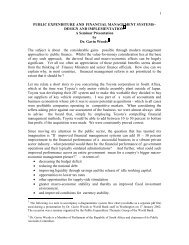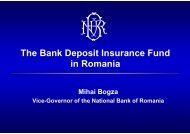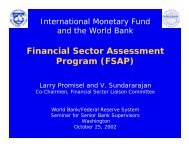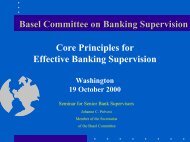By Hennie van Greuning and Sonja Brajovic Bratanovic - World Bank
By Hennie van Greuning and Sonja Brajovic Bratanovic - World Bank
By Hennie van Greuning and Sonja Brajovic Bratanovic - World Bank
Create successful ePaper yourself
Turn your PDF publications into a flip-book with our unique Google optimized e-Paper software.
ANALYZING BANKING RISK<br />
<strong>By</strong> <strong>Hennie</strong> <strong>van</strong> <strong>Greuning</strong> <strong>and</strong> <strong>Sonja</strong> <strong>Brajovic</strong> <strong>Bratanovic</strong><br />
Appendix<br />
GENERAL BACKGROUND QUESTIONNAIRE<br />
(see Table 13.2 in Analyzing <strong>Bank</strong>ing Risk)<br />
Name of bank:<br />
Address:<br />
Date completed:<br />
Telephone number:<br />
Fax number:<br />
Person(s) responsible for<br />
completion:<br />
1. EXECUTIVE SUMMARY AND RECOMMENDATIONS<br />
What are the biggest challenges facing your bank in the next few years?<br />
What are your strategies to overcome those challenges?<br />
What are your bank’s greatest strengths?<br />
What risks do lenders/investors face in lending money to your<br />
organization:<br />
-external to your bank<br />
-internal to your bank?<br />
Why would money lent to your banks be a good investment for<br />
lenders/investors?<br />
How would your bank use money lent by lenders/investors to<br />
develop financial markets or specific sectors in your country?<br />
2. INSTITUTIONAL DEVELOPMENT NEEDS<br />
What are your bank’s greatest development needs as identified in the<br />
conclusions <strong>and</strong> recommendations section (Section 15)at the end of this<br />
report?<br />
Which areas will you focus on in the coming year?<br />
What role can lenders/investors play in assisting you with the development<br />
of your institution?<br />
What active plans do you have to ensure that reforms are sustained?<br />
Who would be the primary contact person in your organization, to<br />
take responsibility for the institutional development plan <strong>and</strong><br />
coordinate with lenders/investors if a loan is granted?
3. OVERVIEW OF THE FINANCIAL SECTOR AND REGULATION<br />
3.1 Status of financial infrastructure (disclosure, payment systems, scrip<br />
registries, <strong>and</strong> so on)<br />
3.2 <strong>Bank</strong>ing <strong>and</strong> the financial system: the status of financial regulation<br />
3.3 <strong>Bank</strong>ing regulation<br />
Which are the key laws affecting the banking system in your country?<br />
When were the banking laws <strong>and</strong> regulations last changed?<br />
Describe the key prudential regulations regarding:<br />
- shareholding<br />
- related party (connected) lending<br />
- large exposures<br />
- loan classification guidelines<br />
- suspension <strong>and</strong> reversal of interest<br />
- investment limits<br />
= for equity investments<br />
= for property <strong>and</strong> other fixed assets<br />
- currency exposure limits<br />
- deposit insurance.<br />
Describe the supervisory approach <strong>and</strong> philosophy (of the<br />
regulators).<br />
What is the minimum capital requirement <strong>and</strong> how do your capital<br />
adequacy guidelines differ from the BIS guidelines?<br />
Describe any cash reserve <strong>and</strong> liquid asset requirements of the<br />
central bank.<br />
How is currency risk regulated?<br />
Are prudential regulations strictly enforced?<br />
4. OVERVIEW OF THE BANK AND ITS RISK MANAGEMENT CULTURE<br />
4.1 Historical background <strong>and</strong> general information<br />
Provide a brief history of the bank, detailing incorporation dates, earlier<br />
names, mergers, major events, <strong>and</strong> so on.<br />
What is your ranking in the banking system (capital <strong>and</strong> assets)?<br />
What is the bank’s main business focus <strong>and</strong> what are its main<br />
product areas?<br />
Describe the strategy of your bank.<br />
What is your bank’s mission statement?
4.2 Group <strong>and</strong> organization structure<br />
Provide a group structure chart showing holding companies, ultimate<br />
controlling entities, associates, <strong>and</strong> subsidiaries. Identify other financial<br />
institutions in the group (include as appendix 1).<br />
Provide an organization chart of the bank under review (include as<br />
appendix 2).<br />
How many departments <strong>and</strong> divisions does the bank have? Name them <strong>and</strong><br />
provide an organization chart describing the key departments <strong>and</strong> divisions<br />
as well as the number of staff in each.<br />
How many branches does the bank have? Describe their geographic spread<br />
<strong>and</strong> size.<br />
How many staff members does the bank have?<br />
How many staff members have a post–high school education?<br />
Provide details about technical institute <strong>and</strong> university graduates.<br />
Identify how the development of human resources complements the<br />
risk focus of the bank. –(This is done to ensure that the right caliber<br />
staff is recruited <strong>and</strong> trained, in order to enable compliance <strong>and</strong><br />
maintenance of the risk management procedures established.)<br />
To what extent are staff paid competitive market-based salaries in<br />
order to retain them?<br />
To what extent are bonuses paid to staff?<br />
What training is offered to staff?<br />
How does the organizational structure encourage good risk<br />
management? (Also see risk management culture, Section 4.5.)<br />
4.3 Accounting systems, management information, <strong>and</strong> internal control<br />
Describe the status of the bank’s accounting systems <strong>and</strong> records.<br />
How much reliance can be placed on the financial reporting <strong>and</strong><br />
information systems?
4.4 Information technology<br />
Describe the computer systems in operation (both hardware <strong>and</strong> software),<br />
including microcomputers (whether used as terminals or st<strong>and</strong>-alone<br />
units).<br />
What backup <strong>and</strong> recovery systems are available?<br />
How is security in the EDP area controlled?<br />
4.5 Risk management culture <strong>and</strong> decisionmaking process<br />
What major risks (stemming either from its products or from the<br />
environment) does the bank face?<br />
Planning <strong>and</strong> defining risk tolerance levels: Have the board <strong>and</strong> executive<br />
management delineated the level of risk they are willing to assume for each<br />
area <strong>and</strong> overall?<br />
Risk identification: How is the risk in current operations identified?<br />
Risk supervision <strong>and</strong> management: How are current <strong>and</strong> proposed<br />
operations managed?<br />
Risk monitoring: Evaluate the effectiveness of control<br />
implementation.<br />
How effectively are board-approved risk tolerance levels<br />
communicated in the organization?<br />
Evaluate the manner in which risk is being assumed, measured,<br />
limited, controlled, <strong>and</strong> reported.
5. CORPORATE GOVERNANCE<br />
5.1 Shareholders / O/ownership<br />
When was the last shareholders’ meeting of the bank <strong>and</strong> how many<br />
shareholders were present? What percentage of the total shares did they<br />
represent?<br />
What is the main business of the key shareholders, <strong>and</strong> who controls those<br />
shareholders?<br />
Are there any provisions allowing shareholders voting rights that<br />
are not in proportion to their shareholding?<br />
Describe any options or other rights given to persons to acquire<br />
more share capital.<br />
Do any resolutions require more than a simple majority to be<br />
accepted? If so, name such provisions.<br />
What direct involvement, if any, do the shareholders have with the<br />
bank, the supervisory board, <strong>and</strong> the management board?<br />
5.2 Board of directors/supervisory board<br />
For how long is the supervisory board elected? What are the board’s main<br />
objectives <strong>and</strong> responsibilities?<br />
Describe the supervisory board’s involvement with bank policy setting,<br />
especially as regards risk management.<br />
To what extent does the supervisory board review financial information<br />
during the year <strong>and</strong> at year end?<br />
Describe the interaction between bank management <strong>and</strong> the bank’s policysetting<br />
board, the responsibility for the determination of the bank’s<br />
policies <strong>and</strong> objectives, delegation of authority <strong>and</strong> responsibility, internal<br />
systems <strong>and</strong> procedures for performance reviews, <strong>and</strong> checks on<br />
accountability.<br />
Is the board of directors (supervisory <strong>and</strong> management boards)<br />
committed to the active use of risk-based management<br />
information? These “ideal” management accounts should be the<br />
driving force in identifying where the bank wishes to see itself in<br />
terms of ideal critical management information. This goal should<br />
determine what other systems development <strong>and</strong> training should take<br />
place, <strong>and</strong> how.<br />
5.3 Executive management<br />
Who appoints the chief executive officer (chairman of the management<br />
board)?<br />
For how long is the management board elected? What are their main<br />
objectives <strong>and</strong> responsibilities?<br />
Elaborate on the interaction between bank management <strong>and</strong> the bank’s<br />
policy-setting board, the responsibility for the determination of bank<br />
policy <strong>and</strong> objectives, delegation of authority <strong>and</strong> responsibility, internal<br />
systems <strong>and</strong> procedures for performance reviews, <strong>and</strong> checks on<br />
accountability.<br />
Discuss the interaction between bank management <strong>and</strong> employees in<br />
carrying out the bank’s objectives.<br />
Do senior management <strong>and</strong> the board receive <strong>and</strong> require risk-based<br />
management information on a regular basis?<br />
Is risk-based management information used to ensure that<br />
procedures are in place to safeguard assets <strong>and</strong> depositors as well as<br />
ensure the integrity of data?<br />
Which management accounts should be developed to identify<br />
critical risk management issues for top management (distinguish<br />
between information needed on a daily basis, <strong>and</strong> information to be<br />
presented on a monthly or less frequent basis for management <strong>and</strong><br />
supervisory board meetings)?<br />
Identify the risk management systems <strong>and</strong> procedures that must be<br />
designed to support the information needs of management, to<br />
ensure that the desire for proper risk management drives all systems<br />
development.
5.4 Internal audit/audit committee of the board<br />
How many persons work in the internal audit department? Describe their<br />
experience <strong>and</strong> qualifications.<br />
Do those who carry out the internal audit function report to a<br />
subcommittee of the supervisory board? If not, to whom do they report?<br />
Do the supervisory board members receive <strong>and</strong> review the internal<br />
audit reports?<br />
Do internal audit reports discuss deviations from policies? What<br />
else is discussed in those reports?<br />
5.5 External auditors<br />
Are International Accounting St<strong>and</strong>ards (IAS) <strong>and</strong> International St<strong>and</strong>ards<br />
of Auditing (ISA) followed?<br />
Who are the external auditors of the bank <strong>and</strong> how long have they been<br />
auditing the financial statements? If they were appointed recently, name<br />
their predecessors.<br />
Identify the major items reported on by the auditors during the past three<br />
years. Supply copies of the latest two management reports from the<br />
auditors.<br />
What audit <strong>and</strong> consulting fees have been paid to the auditors<br />
during the past two years?<br />
To what extent do the auditors evaluate the bank’s risk<br />
management procedures?<br />
Discuss the involvement of <strong>and</strong> relationship between the external<br />
auditors <strong>and</strong> management.
FINANCIAL RISK MANAGEMENT (6–13)<br />
6. Balance sheet structure <strong>and</strong> the changes therein<br />
XXXXXXXXXXXXXXXXXXXXXXXXX<br />
6.1 Composition of the balance sheet<br />
Asset structure: growth <strong>and</strong> changes<br />
Liabilities structure: growth <strong>and</strong> changes<br />
6.2 Overall on- <strong>and</strong> off-balance sheet growth<br />
6.3 Low <strong>and</strong> nonearning assets<br />
6.4 ALCO–planned changes in the<br />
balance sheet structure<br />
Describe:<br />
- what happened<br />
- why it happened<br />
- the impact of the trend or observation<br />
- the planned response to the situation<br />
- alternative recommendations regarding the situation<br />
observed.<br />
Describe the structure of your balance sheet <strong>and</strong> any planned<br />
changes.<br />
Describe (<strong>and</strong> quantify) the nature, volume, <strong>and</strong> anticipated<br />
usage of credit commitments, contingent liabilities,<br />
guarantees <strong>and</strong> other off-balance sheet items.
7. Income statement structure <strong>and</strong> the changes therein (profitability/earnings)<br />
7.1 Sources of income: changes in the structure <strong>and</strong><br />
trends of income<br />
7.2 Structure of assets compared to structure of income<br />
7.3 Margins earned on intermediation business<br />
7.4 Operating income <strong>and</strong> operating expenses<br />
breakdown<br />
7.5 Return on assets <strong>and</strong> shareholders’ funds<br />
Describe:<br />
- what happened<br />
- why it happened<br />
- the impact of the trend or observation<br />
- the planned response to the situation<br />
- alternative recommendations are regarding the situation<br />
observed<br />
Describe your major sources of income <strong>and</strong> most profitable<br />
business areas.<br />
Describe the extent to which accrued but uncollected interest is<br />
taken into income—especially if such interest income relates to<br />
loans that you or the bank place in risk categories of subst<strong>and</strong>ard or<br />
worse.<br />
Describe the extent to which collateral values (rather than operating<br />
cash flows) are the basis for decisions to capitalize interest <strong>and</strong> /or<br />
to roll over extensions of credit.<br />
List any income or expenditure recognition policies that might<br />
affect (or distort) earnings.<br />
Describe the effect of material intergroup transactions, especially<br />
those relating to the transfer of earnings <strong>and</strong> asset /liability<br />
valuations.<br />
Are there any revenue <strong>and</strong> expense items that may be significantly<br />
overstated or understated?<br />
Describe areas <strong>and</strong> the manner in which greater efficiencies can be<br />
achieved.
8. Capital adequacy<br />
8.1 Capital retention policies<br />
8.2 Compliance with capital adequacy requirements<br />
8.3 Potential future capital requirements<br />
8.4 Structure of shareholders’ funds<br />
8.5 Risk profile of balance sheet assets<br />
Describe:<br />
- what happened<br />
- why it happened<br />
- the impact of the trend or observation<br />
- the planned response to the situation<br />
- alternative recommendations regarding the situation<br />
observed<br />
What plans do you have for the maintenance of minimum<br />
regulatory capital, given your past growth <strong>and</strong> future plans for<br />
expansion?<br />
What access does the bank have to capital <strong>and</strong> financial assistance?<br />
What are the bank’s growth experiences, plans, <strong>and</strong> prospects for<br />
the future?<br />
Is capital growth funded by internal cash generation or capital<br />
contributions?<br />
To what extent have reserves been generated by revaluations of<br />
fixed assets, <strong>and</strong> investments, or from the capitalization of interest<br />
on classified loans?<br />
In the case of capital contributions, were they in cash or in kind<br />
(fixed assets)?<br />
In the case of contributions in kind (fixed assets), state the<br />
proportion that such contributions (see Table 5.3A) constitute as a<br />
percentage of total capital <strong>and</strong> describe the process used to obtain a<br />
reliable third party valuation.
9. Credit risk management<br />
9.1 Credit risk management policies, systems, <strong>and</strong><br />
procedures<br />
Use the structure of Section 4.5 (risk management culture) to discuss<br />
the following questions:<br />
How is credit risk managed in the bank? Include a description of the<br />
lending organization, concerned departments, management levels, <strong>and</strong><br />
staffing.<br />
Provide the profile <strong>and</strong> lending skills of your chief lending officers, credit<br />
managers <strong>and</strong> officers, <strong>and</strong> all rele<strong>van</strong>t staff.<br />
Describe the key risks that you face <strong>and</strong> control in this area.<br />
What are your strengths as far as this risk area is concerned?<br />
What are the most pressing development needs for your bank as far as<br />
this risk area is concerned?<br />
Describe the top-level information prepared for the most senior<br />
management in the bank.<br />
What information is asked for during the loan application request?<br />
Describe the contents of loan files. –How do you use this information to<br />
monitor the quality of loans?<br />
Describe the st<strong>and</strong>ard loan process from the client’s initial enquiry, or the<br />
bank’s marketing efforts, to the final lending decision, <strong>and</strong> a description<br />
of the credit decision process.<br />
What are the criteria used for granting loans? Also describe any specific<br />
limits, ratios, <strong>and</strong> so forth used by you in the evaluation process.<br />
Describe any specific lending procedures <strong>and</strong> techniques for project<br />
appraisal, approvals <strong>and</strong> legal finalization of projects, procurement <strong>and</strong><br />
disbursement, as well as follow-up <strong>and</strong> supervision of such projects.<br />
Describe any formalized credit policies, procedures, <strong>and</strong><br />
underwriting criteria for the identification of target markets.<br />
Discuss the procedures for management of problem loans, describing<br />
specialized work-out departments or intensive care units <strong>and</strong><br />
detailing their scope, skill, resources, <strong>and</strong> efficiency.<br />
What instruments or remedies are available to ensure that borrowers<br />
repay their loans to the bank; describe also the mechanisms that exist<br />
for legal recovery, foreclosure <strong>and</strong> repossession of collateral, <strong>and</strong><br />
transmission of legal rights.<br />
Describe the taxation deductions allowed for loan loss provisioning<br />
as well as the influence that taxation has on your bank’s provisioning<br />
policy.<br />
At what point do you suspend interest <strong>and</strong> how do you control the<br />
overall amounts owed by a client in such a case?<br />
What is the total number of corporate <strong>and</strong> retail loans?<br />
Has your bank made any loans on other than normal credit terms<br />
(pricing or directed)?<br />
To what extent have you accepted equity in clients as payment for<br />
loans?<br />
What percentage of loans have been rescheduled once?<br />
What percentage of loans have been rescheduled more than once?<br />
For what percentage of loans do you act as a fiscal agent ?
9.2 Profile of borrowers<br />
9.3 Maturity of loans<br />
9.4 Loan products<br />
9.5 Sectoral analysis of loans<br />
9.6 Large exposures to individuals <strong>and</strong> connected<br />
parties<br />
9.7 Loan <strong>and</strong> other asset classification <strong>and</strong> provisioning<br />
9.8 Analysis of loans in arrears<br />
9.9 Connected lending (to related parties)<br />
Describe:<br />
- what happened<br />
- why it happened<br />
- the impact of the trend or observation<br />
- the planned response to the situation<br />
- alternative recommendations regarding the situation observed<br />
Describe the major loan products offered by the bank.<br />
Describe your bank’s current policies, practices, <strong>and</strong> procedures to<br />
identify common ownership, control, <strong>and</strong> reliance on common cash<br />
flows. You should also, if appropriate, suggest new guidelines <strong>and</strong><br />
new procedures by which concentrations should be identified <strong>and</strong><br />
tracked in the bank.<br />
Are all assets (in addition to the loan portfolio) with a credit risk in<br />
fact classified as to quality <strong>and</strong> provided against, when needed?<br />
Describe your methodology for the determination of the level of<br />
reserves required.<br />
To what extent do you rely on collateral for establishing the<br />
recommended reserves? Specify the methodology used to establish<br />
the value of the collateral? –What types of collateral do you regard<br />
as acceptable?<br />
Under what circumstances do you use specific reserves <strong>and</strong> when<br />
are general reserves used?
10. Liquidity risk management<br />
10.1 Liquidity risk management policies, systems, <strong>and</strong><br />
procedures<br />
Use the structure of Section 4.5 (risk management culture) to discuss<br />
the following questions:<br />
How is liquidity risk managed in the bank?<br />
Describe the key risks that you face <strong>and</strong> control in this area.<br />
Describe the top-level information prepared for the most senior<br />
management in the bank.<br />
What are your strengths as far as this risk area is concerned?<br />
What are the most pressing development needs for your bank as far as this<br />
risk area is concerned?<br />
How many persons work in the treasury? –Describe their daily activities<br />
(split between domestic <strong>and</strong> international if applicable) in ensuring that the<br />
bank’s funding is adequate to meet its deposit liabilities <strong>and</strong><br />
investment/lending commitments.<br />
How strong is the interbank market? What is your participation in<br />
those markets?<br />
Do you have adequate access to money markets or other ready<br />
sources of cash? If so, please describe these sources.<br />
What reliance does your bank place on interest-sensitive funds?<br />
To what extent do you make use of central bank credit? Report<br />
how many times you used central bank credit in the last 12 months,<br />
describing the different types of access used <strong>and</strong> the maximum<br />
amount involved.<br />
What ability do you have to readily convert assets into cash?<br />
Describe your capacity to meet unexpected deposit withdrawals <strong>and</strong><br />
other dem<strong>and</strong>s for payment.<br />
What other sources of funding do you have available in case of a<br />
shortage of liquidity.<br />
How many depositors does the bank have in total?<br />
10.2 Compliance with regulatory requirements<br />
10.4 Sources of deposits—profile of depositors<br />
10.3 Maturity structure of deposits<br />
10.5 Large depositors <strong>and</strong> volatility of funding<br />
10.6 Maturity mismatches of assets <strong>and</strong> liabilities<br />
10.7 Liquidity risk measures<br />
Describe:<br />
- what happened<br />
- why it happened<br />
- the impact of the trend or observation<br />
- the planned response to the situation<br />
- alternative recommendations regarding the situation observed
11. Interest rate risk management<br />
11.1 Interest rate risk management policies, systems, <strong>and</strong> procedures<br />
Use the structure of Section 4.5 (risk management culture) to discuss<br />
the following questions:<br />
How is interest rate risk managed in the bank?<br />
Describe the key risks that you face <strong>and</strong> control in this area?<br />
Describe the top-level information prepared for the most senior<br />
management in the bank?<br />
What are your strengths as far as this risk area is concerned?<br />
What are the most pressing development needs for your bank as far<br />
as this risk area is concerned?<br />
11.2 Forecasting of interest rates<br />
11.3 Measures to determine the potential impact of<br />
exogenous rate movements on the bank’s capital<br />
Describe:<br />
- what happened<br />
- why it happened<br />
- the impact of the trend or observation<br />
- the planned response to the situation<br />
- alternative recommendations regarding the situation<br />
observed
12. Market/price risk management<br />
12.1 Market/price risk management policies, systems,<br />
<strong>and</strong> procedures<br />
Use the structure of Section 4.5 (risk management culture) to discuss<br />
the following questions:<br />
Describe the top-level information prepared for the most senior<br />
management in the bank.<br />
What are your strengths as far as this risk area is concerned?<br />
What are the most pressing development needs for your bank as far<br />
as this risk area is concerned?<br />
To what price risk/market risk is the bank exposed as a result of its trading<br />
in the securities, commodities, equities, or other markets?<br />
How is market risk managed in the bank?<br />
Describe the key risks that you face <strong>and</strong> control in this area.<br />
12.2 Structure of the investment portfolio<br />
12.3 Structure of the trading portfolio<br />
12.4 Net effective open positions <strong>and</strong> potential capital<br />
exposures<br />
12.5 Market risk attached to off-balance-sheet activities<br />
<strong>and</strong> derivatives<br />
Describe:<br />
- what happened<br />
- why happened<br />
- the impact of the trend or observation<br />
- the planned response to the situation<br />
- alternative recommendations regarding the situation<br />
observed
13. Currency risk management<br />
13.1 risk management policies, systems, <strong>and</strong> procedures<br />
Use the structure of Section 4.5 (risk management culture) to discuss<br />
the following questions:<br />
What are your strengths as far as this risk area is concerned?<br />
What are the most pressing development needs for your bank as far<br />
as this risk area is concerned?<br />
How does the bank manage its currency risks?<br />
Describe the key risks that you face <strong>and</strong> control in this area?<br />
Describe the top-level information prepared for the most senior<br />
management in the bank?<br />
13.2 Currency structure of assets <strong>and</strong> liabilities<br />
13.3 Currency structure of off-balance-sheet activities<br />
13.4 Maturity structure of foreign currency liabilities<br />
13.5 Currency structure of loans <strong>and</strong> deposits<br />
13.6 Net effective open position <strong>and</strong> capital exposed<br />
Describe:<br />
- what happened<br />
- why it happened<br />
- the impact of the trend or observation<br />
- the planned response to the situation<br />
- alternative recommendations regarding the situation observed
14. OPERATIONAL RISK<br />
Discuss risks resulting from the following areas:<br />
14.1 Human resources<br />
14.2 Potential loss of data<br />
14.3 Payments <strong>and</strong> settlement transactions<br />
The possibility of loss resulting from errors in instructing payments or<br />
settling transactions<br />
14.4 Other technological risk<br />
14.5 Legal issues<br />
The possibility of loss when a contract cannot be enforced (e.g., because the<br />
client had no authority to enter into the contract or the contract turned out to<br />
be unenforceable in a bankruptcy proceeding)<br />
15. CONCLUSIONS AND RECOMMENDATIONS<br />
Discuss the following:<br />
15.1 The changes that appear necessary within the bank’s culture <strong>and</strong><br />
managerial practices, given the nature <strong>and</strong> relative complexity of its<br />
operations, including (as applicable):<br />
• The need for full sponsorship by the board <strong>and</strong> executive<br />
management.<br />
• The necessary enabling culture in which every manager is expected<br />
to consider risk (i.e., to identify, measure, <strong>and</strong> report on risk<br />
exposure.<br />
• The changes that appear necessary after the assessment of evaluation,<br />
monitoring, <strong>and</strong> reporting systems that cover critical risk functions.<br />
• The convenience of adopting appropriate risk objectives for each<br />
function <strong>and</strong> for the bank as a whole.<br />
• The need to institute a formal process for the general manager or<br />
CEO of the bank <strong>and</strong> the board to review <strong>and</strong> evaluate all expected<br />
<strong>and</strong> unexpected risks <strong>and</strong> all risk-taking activities.<br />
• The convenience of designating a member of senior executive<br />
management for overseeing all risk management, with<br />
authority to act on risk problems <strong>and</strong> ensure risk control;<br />
15.2 The implications of the problems identified <strong>and</strong> for instituting<br />
a bank-wide risk management function, the process <strong>and</strong> phases<br />
required for such action, <strong>and</strong> the role <strong>and</strong> function within the<br />
organization of the risk management senior official.<br />
15.3 The manner in which risk management functions could be<br />
instituted in the bank.<br />
15.4 The feasibility of installing effective comprehensive bankwide<br />
risk management, <strong>and</strong> their implications for the bank.
Group Structure<br />
Attach a diagram<br />
Organization Structure<br />
Attach a diagram
Shareholding*<br />
Shareholders (as of ______)<br />
Number of<br />
Shareholders<br />
Shares Held<br />
Percentage of Shares<br />
Private companies<br />
Private individuals<br />
Subtotal: private sector shareholders<br />
Public sector <strong>and</strong> government companies (less than 51 percent<br />
private) **<br />
Total shareholding<br />
Number<br />
Unit Size<br />
List of shareholders who own more than 5 percent of the bank’s<br />
shares<br />
Name Shares Held Percentage of Shares<br />
Number<br />
Unit Size<br />
List of shareholders <strong>and</strong> companies that effectively or indirectly own more than 5 percent of the bank's shares through their control over<br />
shareholders of the bank<br />
* The ultimate (<strong>and</strong> real) owner of the shares must determine whether the shareholder is from the private or the public sector.<br />
** If shares are held as nominees, indicate who the ultimate owner is.
Supervisory Board/Board of Directors<br />
Name<br />
Where<br />
Employed<br />
Shareholders/Entity<br />
Represented<br />
Majority Private Sector-<br />
Owned (Y/N)<br />
Qualifications Experience Responsibility*<br />
* Responsibility examples: administration, corporate banking, international division, domestic treasury, retail banking, internal control, finance <strong>and</strong> accounting,<br />
information systems, branch management.
Management Board (Executive Management)<br />
Name Qualifications Experience Responsibility *<br />
* Responsibility examples: administration, corporate banking, international division, domestic treasury, retail banking, internal control, finance <strong>and</strong> accounting,<br />
information systems, branch management.
Appendix 4.3.B Reports Prepared for Top Management<br />
Daily<br />
Weekly<br />
Monthly<br />
Quarterly<br />
Annually<br />
Other<br />
For Department Heads For Executive Management For Supervisory Board



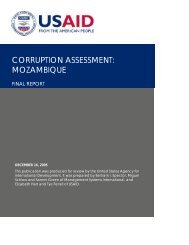
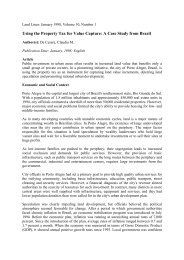

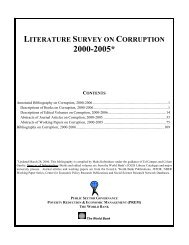

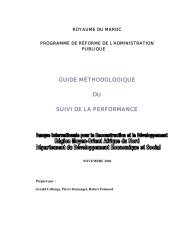
![Budget Execution: Overview [PDF 453K]; Bill Dorotinsky - World Bank](https://img.yumpu.com/47844909/1/190x143/budget-execution-overview-pdf-453k-bill-dorotinsky-world-bank.jpg?quality=85)
